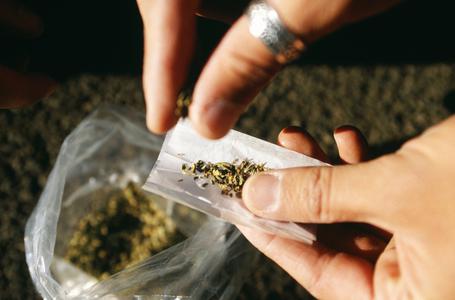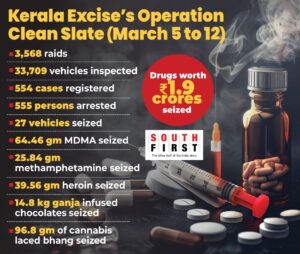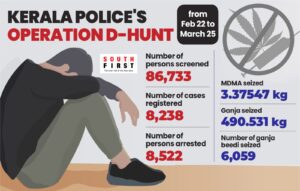A series of drug-fuelled violent incidents has prompted Kerala to crackdown on those transporting, supplying and peddling the banned substance. It’s a fight that Kerala must win to save its youth.
Published Mar 29, 2025 | 3:00 PM ⚊ Updated Apr 12, 2025 | 11:29 AM

Kozhikode aims for record-breaking anti-drug pledge on international anti-drug day (Wikimedia Commons)
Synopsis: South First brings you a series on drug menace in Kerala. Bengaluru’s nightlife and underground drug networks are fuelling Kerala’s synthetic drug crisis, while Andhra Pradesh and Odisha are emerging as top cannabis suppliers, according to the Kerala Excise Department. Read the first part of the series, that exposes how Kerala is cooking its own narcotics, here.
Kerala is in the grip of an unprecedented drug crisis, turning a once-muted concern into a raging debate.
Shocking incidents of drug-fuelled violence, even involving children, have set off alarm bells, forcing swift government action.
A high-level meeting was convened, to be followed with a massive stakeholder summit set for Sunday, 30 March.
Meanwhile, enforcement agencies, through operations like ‘D-Hunt’ and ‘Clean Slate,’ are making record-breaking seizures and arrests.
But the bigger mystery looms—where are these drugs coming from?
Is Kerala a mere transit hub for global cartels, or do clandestine labs and interstate networks fuel the menace?
As the state ramps up its war on drugs, the real question remains: Who is pulling the strings?
Bengaluru’s nightlife and underground drug networks are fuelling Kerala’s synthetic drug crisis, while Andhra Pradesh and Odisha are emerging as top cannabis suppliers, according to the Kerala Excise Department.

Operation Clean Slate.
Excise officials have traced Kerala’s synthetic drug supply—MDMA, methamphetamine, and designer drugs—back to Bengaluru, where foreign nationals, including Nigerians, Ghanaians, and Tanzanians, play key roles in manufacturing and distribution.
“Many foreign students in Bengaluru are skilled in drug processing,” an excise official said.
Meanwhile, cannabis trafficking follows a different route, originating from Maoist-controlled regions in Andhra Pradesh and Odisha.
Excise inspector Philip Thomas recalled to South First a recent operation that seized 247 kg of cannabis from Andhra Pradesh. “Smugglers, realising we were tracking them, sent the consignment via courier. We traced the shipment and arrested the lorry driver,” he said.
Narsipatnam in Andhra Pradesh’s Anakapalle district is notorious for cannabis cultivation, with Malayalis taking land on lease to grow it over 500-600 hectares. The cannabis is compressed into 2 kg cubes using hollow brick machines for easier transport.
Officials warn that trafficking networks are expanding to Assam, using migrant workers and interstate buses.
“Synthetic drugs come mainly from Karnataka, while cannabis is trafficked from Andhra and Odisha,” Pradeep VA, Joint Commissioner of Excise told South First.
Kerala’s 590-km coastline, combined with inland waterways and well-connected airports including four international airports have made it a key entry point for drugs smuggled from abroad and within.

Operation D-Hunt.
International cartels and local operatives exploit maritime routes, courier services, and advanced methods like cryptocurrency and the dark web to traffic synthetic drugs into the state.
Drugs from Southeast Asia, particularly Thailand and Malaysia, enter Kerala via courier services and sea routes.
In February 2025, officials intercepted 1 kg of ganja sent from Thailand to Kochi through the International Post Office, highlighting the role of postal networks in trafficking.
The Middle East, especially Oman and Iran, has also emerged as a major source.
A significant bust in March 2025 in Malappuram led to the seizure of 1.66 kg of MDMA worth ₹70 lakh.
The racket, led by Ashique P Umer, a supermarket owner with ties to Oman, marked a shift in supply routes from Bengaluru to Gulf-based networks.
Meanwhile, cocaine and heroin from Africa and Latin America enter India through Mumbai and Gujarat before reaching Kerala.
The drugs were suspected to have originated from the Golden Triangle—a notorious drug-producing region spanning Myanmar, Laos, and Thailand—or from Latin America, before being routed through international waters.
Excise officer Philip Thomas highlighted the growing influence of global drug-producing regions in Kerala’s drug market.
“Poppy cultivation is widespread in countries like Pakistan, Afghanistan, and Iran, known as the Golden Crescent, as well as in Myanmar, Thailand, and Laos, which form the Golden Triangle. With its vast coastline and trade routes, India has become a prime destination for these networks, especially through Gujarat’s ports,” he said.
A member of the District Anti-Narcotics Special Action Force (DANSAF) in Ernakulam noted that Kerala’s tourism-driven economy and proximity to international waters make it an attractive hub for drug smugglers.
“Foreign nationals especially Nigerians and Tanzanians have been arrested in large numbers, and many remain in detention centers. They form connections with local drug peddlers and gangs to distribute drugs,” the official said.
He also pointed out that business ties with Dubai-based individuals are being exploited to penetrate Kerala’s local drug market.
Officials warn that Kerala’s tourism industry and expatriates also facilitate drug inflow with locals playing key roles in distribution networks.
The growing use of synthetic drugs among Kerala’s youth has led to increasingly sophisticated smuggling methods and communication strategies, making law enforcement’s job more challenging.
Unlike traditional drugs like cannabis, synthetic substances such as MDMA, LSD, and methamphetamine are compact, potent, and easy to conceal—factors that contribute to their popularity at parties and social gatherings.
Drug users and traffickers employ innovative tactics to evade detection.
Some mix MDMA into food items like biscuits or candies, as seen in a case where a schoolgirl was introduced to drugs through MDMA-laced biscuits.
Others microdose LSD or MDMA during school/college hours, subtly experiencing its effects without raising suspicion.
E-cigarettes and vape pens have also become tools for discreetly consuming crystal methamphetamine, mimicking global drug trends.
Smugglers leverage everyday objects such as hollowed-out pens, lip gloss containers, and even household appliances.
In one instance, a woman from Bengaluru was caught at Aluva railway station with a kilogram of MDMA concealed inside a heater.
Rental cars, fitted with magnetic compartments under their chassis, are used to transport drugs across state borders.
With heightened security on public transport, traffickers have shifted to private courier services and international postal networks. Cases of LSD blots arriving from Germany or ganja smuggled from Thailand through Kochi’s International Post Office highlight these evolving strategies.
Encrypted messaging platforms like WhatsApp further complicate law enforcement efforts.
Traffickers use cryptic messages, coded emojis, and secret jargon to coordinate deliveries, making tracking and interception difficult.
Sharon Thomas (name changed), a Kochi resident undergoing psychiatric treatment for drug addiction, shared his experience of getting involved with drug peddlers near Kaloor International Stadium in Kochi.
“Many street vendors selling picture cards, perfumes, and other small items play a key role in introducing youngsters to local drug dealers. I was a fan of Van Gogh’s paintings and often bought picture cards from a young boy near Kaloor Stadium. While many vendors rely on these sales for a living, some misuse the opportunity, approaching potential customers with coded offers for drugs. This boy introduced me to a dealer from Tamil Nadu, who supplied ‘Molly’ to me and my friends. It helped us stay energetic during our graveyard shifts at Technopark. Users like us never know the deeper roots of the drug trade—we only connect with the local peddlers.”
Though the flow of drugs is coming from other states, agencies concerned are increasingly alarmed by signs of domestic synthetic drug production in Kerala, as recent busts and investigations reveal a disturbing trend.
In July 2024, Kerala Police dismantled the state’s first identified synthetic drug manufacturing network in Thrissur.
What began as a 2.5 kg MDMA seizure unraveled a deep connection to a Hyderabad-based drug lab, exposing a critical supply chain linking Kerala traffickers to domestic production units.
Investigations in early 2025 uncovered a group of Kasaragod youth undergoing training in MDMA production labs in Bengaluru, sparking fears that they were preparing to replicate such operations within Kerala.
Kochi has emerged as a hotspot for smuggling precursor chemicals like ephedrine and pseudoephedrine, essential ingredients in methamphetamine production.
Coastal police reports suggest a spike in smuggling via sea routes, indicating potential experimentation by local clandestine chemists.
The massive 2,525 kg methamphetamine bust near Ernakulam in 2023 underscored the state’s role in the synthetic drug trade. Officials fear that Kerala-based networks are actively involved in repackaging and distributing synthetic drugs, further embedding the region in the global narcotics supply chain.
With training camps, chemical smuggling, and local production attempts on the rise, authorities now face a critical battle to prevent Kerala from becoming a synthetic drug hub.
The enforcement agencies are facing increasing challenges in their efforts to combat drug trafficking, with officers citing severe operational risks and resource constraints.
Officials stress the need for improved interstate coordination, better technology, and a multi-agency crackdown to dismantle organized drug networks.
Speaking to South First, a senior official, highlighted the dangers faced by officers during operations. “We can’t even use our IDs to book hotel rooms because local informants might tip off criminals, putting our lives in danger,” he explained.
He emphasised the urgent need for cooperation between states to effectively curb drug trafficking.
“Without collaboration between states, tackling this menace is impossible. The state government must take proactive steps to eliminate drugs at their source,” he urged.
A highly placed source from the Excise Department also shed light on the operational difficulties faced by their personnel.
“The Excise Department operates with a limited number of officials, and those willing to take high risks are rare. Despite these constraints, we have managed to perform well, even seizing drugs from distant locations like the Andaman Islands. However, in certain cases—especially in states like Andhra Pradesh and Odisha—it is neither feasible to operate alone nor always safe to share information with others. Some cases require military-level operations, but we lack the authority to request such support.”
One of the key issues hampering drug enforcement efforts is the lack of access to advanced drug detection devices.
“We often rely on district dog squads to conduct checks at railway stations and bus stands, but this is not always possible,” the official added.
The increasing vulnerability of children to drug abuse has also become a major concern. “Many children today are lonely and lack playgrounds, making them easy targets for drug mafias who operate online,” he noted.
Officials assert that without stringent measures and coordinated efforts across multiple agencies, dismantling drug operations will remain an uphill battle. They have called for better funding, improved intelligence-sharing mechanisms, and the deployment of modern technology to strengthen anti-drug operations in the state.
The state’s drug crisis has evolved from a muted concern to a full-blown emergency, demanding urgent and sustained action. The challenges are multi-dimensional thus making the battle even tougher.
While government-level interventions are pivotal, equally important is community involvement—educational institutions, parents, and social organisations playing a proactive role in preventing drug abuse at the grassroots level.
The fight is long, but losing is not an option.
(Edited by Majnu Babu).
